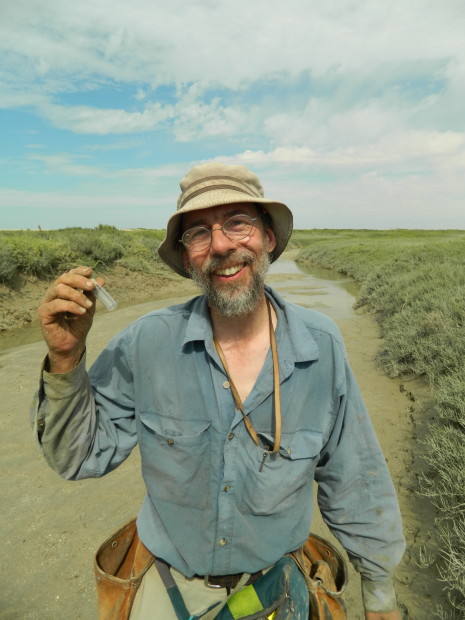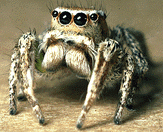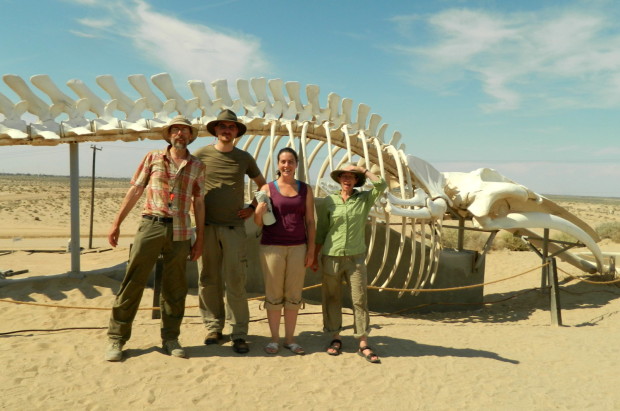Contributor Intercultural Center for the Study of Deserts and Oceans

“When I was 13 years old, I caught my first spider to raise as a pet, so my passion about spiders started early on. I was fascinated with every new discovery about my first spider, so I started collecting and studying them.” So said Dr. Wayne Maddison, Professor of Zoology & Botany at the University of British Columbia, while he was collecting spiders this summer at the Estero Cerro Prieto (Black Mountain Estuary), assisted by CEDO staff. Over time Wayne specialized on the spider family Salticidae focusing on the genus Habronattus. Today, he is able to recognize almost every known species of this genus and his research has led to the discovery of several new species as well.
Salticidae is a Latin name that makes reference to the act of jumping, the reason why this special group of spiders is known as “Jumping Spiders.” The “jump” is an adaptation to get away from predators, as well as to hunt their prey. It’s easy to recognize them because of the four big eyes they have on the face and four smaller ones on the head, a feature that provides them with excellent vision. This evolved vision helps them to locate their prey at a distance, then to pounce and catch their prey, similar to the way cats do it. Even though they are able to jump a distance of 30 times their body length, they don’t have enlarged muscles. The force to  jump probably originates in the front part of their bodies by the contraction of muscles that increases the blood pressure to make their legs extend rapidly like the old fashioned toy frogs that had a bulb you could squeeze to make it hop.
jump probably originates in the front part of their bodies by the contraction of muscles that increases the blood pressure to make their legs extend rapidly like the old fashioned toy frogs that had a bulb you could squeeze to make it hop.
The genus Habronattus belongs to the Salticidae family. Dr. Maddison describes it as a remarkable genus because of the complex courtship behaviors that males display, as well as their ornamentation. These factors make them comparable to birds of paradise. To understand this courting behavior he has filmed it; and sometimes while he talks enthusiastically about the genus, he acts it out! (Visit one of Wayne’s online publications)
During his first visit to the Morúa Estuary in the 90’s Wayne collected very rare specimens that seemed to have physical and DNA features shared between two different species, information that made him think it could be a hybrid organism or a new species. Many questions started to emerge: If it is a hybrid, what causes the parental species to mate when they are separate species? Is this a common happening between these species? To answer these and more questions it was necessary to collect more specimens for DNA studies, learn more about its habitat, and if possible, find out more about the parental species too. Finally this year he came back to Puerto Peñasco accompanied by Heather Proctor (expert on mites, especially soil mites, feather mites and water mites), Geneviéve Leduc-Robert (studying the DNA evolution of the genus Habronattus) and Samuel Evans (working on addictiveness of foraging strategies in orb-weaving spiders.) All of them were highly motivated to find that rare specimen.
When they arrived to CEDO’s field station they signed in under the team name “The Spider Hunters,” and during their stay, guided by CEDO’s field intern, visited different areas of the Morúa Estuary, each day searching for jumping spiders of all types, but mainly the specimen collected by Wayne so long ago. The second day when they were leaving the estuary Wayne stopped to examine some spiders he saw under a bush and surprisingly he found one organism of the species he collected in the past. It seemed that was the perfect place to collect, but suddenly things changed, and the specimen became elusive. Time passed with interesting findings but with no more clues about the special Habronattus species.

Photo: CEDO
The end of the journey approached but Wayne decided not to give up and he dedicated his last hours in the area to visiting a different estuary. Accompanied by CEDO’s field intern, he headed for the Cerro Prieto Estuary (Black Mountain Estuary) and – like in a TV Naturalist Show – during the last hours of the last day, the objective appeared to Wayne’s eyes, followed by other male and female individuals. The excitement made the experience unforgettable! After 20 years since it was first collected, the spider decided to come out of anonymity for the sake of science. Now Wayne, Heather, Geneviéve and Samuel not only will help to find answers about this specimen, but also their findings will contribute to better knowledge of the Upper Gulf of California region. CEDO will continue to stay in touch with them, and we will inform you what’s going on with “The Spider Hunters.”
Biól. Abraham Meza López Editor: Sherie Steele
Cazadores de Arañas en Puerto Peñasco
Colaborador: CEDO
“Cuando tenía 13 años, atrapé mi primera araña para verla crecer como mascota, entonces mi pasión por las arañas empezó desde entonces. Me fascinaba cada descubrimiento nuevo referente a mi primera araña, entonces empecé a coleccionarlas y estudiarlas,” así lo comentó Dr. Wayne Maddison, Profesor de Zoología y Botánica en la Universidad de British Columbia de Canadá, mientras coleccionaba arañas este verano en el Estero Cerro Prieto, apoyado con personal del Centro Intercultural de Estudios de Desiertos y Océanos (CEDO).
….
Durante su primera vista al Estero Morúa en los 90s, el Doctor. Maddison colecionó especímenes muy raras que parecían poseer características físicas y su ADN compartido entre dos especies diferentes, lo cual le hizo pensar que pudiera ser un organismo hibrido o una especie nueva. Empezaron a surgir varias preguntas: En caso de que fuera hibrido, que es lo que causa reproducir la especie paternal cuando son especies separadas? Es común lo que esta pasando entre estas especies? Para resolver estas preguntas y otras era necesario coleccionar más especímenes para estudiar su ADN, conocer mas sobre su hábitat, y si fuera posible, conocer mas sobre las especies paternos. Por fin, este año regresó el Doctor. Maddison a Puerto Peñasco, acompañado por Heather Proctor (experta en ácaros, especialmente los ácaros del suelo, de pluma, y del agua), Geneviéve Leduc-Robert (quien estudia la evolución del ADN del género Habronattus), y Samuel Evans (quien se encuentra trabajando en la adicción de las estrategias de forrajeo entre las arañas araneidas) . Todos venían muy motivados a encontrar este raro espécimen.
Al llegar a CEDO se apuntaron bajo el nombre de equipo “Los Cazadores de Arañas” y durante su estancia, guiados por el personal pasante del CEDO, visitaron diferentes partes del Estero Morúa diariamente en busca de arañas saltadoras (saltícida).
…
Al acercarse el final de su viaje, Wayne decidió no rendirse y se dedicó las últimas horas en el área a visitar un estero diferente. Acompañado por el personal pasante , se dirigió al Estero Cerro Prieto y – así como una serie naturalista en la televisión – durante las últimas horas del día apareció el objeto ante sus ojos, seguido por otros individuos tanto machos como hembras. La emoción ya había convertido la experiencia en un momento inolvidable! Desde hace 20 años cuando fue captada por primera vez, la araña decidió salirse de su anonimia por el bien de la ciencia. Ahora Wayne, Heather, Geneviéve, y Samuel no solamente ayudarán en buscar respuestas referente a esta especie, sus investigaciones también contribuirán a tener más conocimiento referente a la región del Alto Golfo de California.
